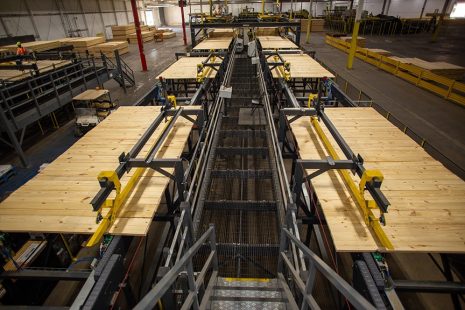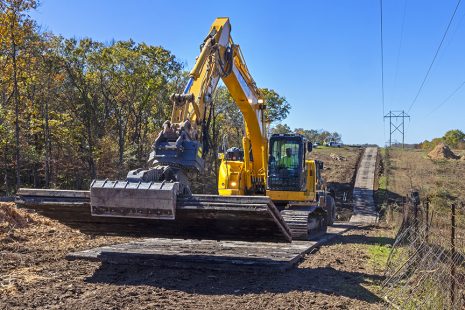CLT, or Cross-Laminated Timber, is the basis of construction for Sterling’s TerraLam CLT mat. Used to build temporary access roads as part of a site access or ground protection plan, these innovative mats have quickly gained acceptance into the site access industry. TerraLam CLT mats have been adopted on major power transmission and oil & gas projects throughout the United States and Canada.
What is CLT?
Cross-Laminated Timber mats are an engineered wood product created by using alternating perpendicular wood layers and glue to create a larger and stronger solid panel of wood. Because of their construction, they are incredibly durable, lightweight, and sustainable.
What is CLT used for?
This technology was created to build panels designed to be used in construction projects in Europe in the 1990’s. Sterling took the CLT process and in 2014 adapted it for site access and ground protection mats.
What are the advantages of CLT mats?
Cross-laminated timber mats outperform traditional bolted mats in a variety of ways. Our TerraLam CLT mats last longer, are more efficient to transport and move along the right-of-way, and are far most sustainable. CLT mats are perfectly suited for use on all rights-of-way and construction projects where ground protection is needed.
Watch how TerraLam CLT mats outlast a timber mats during an accelerated life test during a recent demonstration.
What wood is used for CLT?
Traditional timber mats use hardwoods while CLT uses pine or other softwoods. After careful research and testing, Sterling chose southern yellow pine (SYP) because of its durability and strength, meaning that it will last throughout the wear and tear that temporary access roads and working platforms.
Sustainability is also a driving factor in choosing SYP. It takes between 25-30 years for SYP to regrow in managed forests throughout the United States versus 80-100 years for hardwoods used in traditional bolted mats.
How are CLT mats built?
Sterling uses an automated process to create TerraLam CLT mats. SYP boards are planed to within a .011” tolerance to ensure perfect bond line strength. They are then grouped and placed into our automated line where they are assembled using a moisture-activated polyurethane adhesive that is chemically inert once it cures.
TerraLam mats are then put under more than 2-million pounds of force for tight adhesion. Once they cure, the CLT mats are cut to specification and the ends are coated with a moisture-repelling paint.
Unlike other mat manufacturers, Sterling uses multiple quality assurance tests on to measure the strength and durability of the adhesive bond of the TerraLam mats according to industry standards. These quality assurance tests mean you get a consistent, quality mat every time.
Can CLT mats be reused at different job sites?
Because the CLT mats are a single solid piece of adhered wood, they can be easily cleaned with a scraper or power washer in a mat yard or on a job site before being moved to the next project. Sterling also uses its mobile automated mat washing system to quickly clean mats at their manufacturing facilities near Chicago and in Lufkin, Texas.
Can CLT mats be repaired?
These mats are easily repaired using tools you already have on the ROW. With traditional bolted mats, if you lost a bolt, you lost that mat. Because of the solid construction of CLT mats, team members can quickly replace a damaged board without destroying the integrity of the mat.
How do you dispose of a CLT mat?
It is easier and more environmentally friendly to dispose of CLT mats than traditional bolted mats. First off, there are no bolts to worry about! Once they reach the end of their useful life, CLT mats can be reused in a variety of ways, including being ground for mulch, used for livestock bedding, or even becoming a component of bio-fuel.
Do you have more questions about CLT mats and how they can help make your job site more efficient and environmentally friendly? Contact us below and one of the matting experts will contact you shortly!

